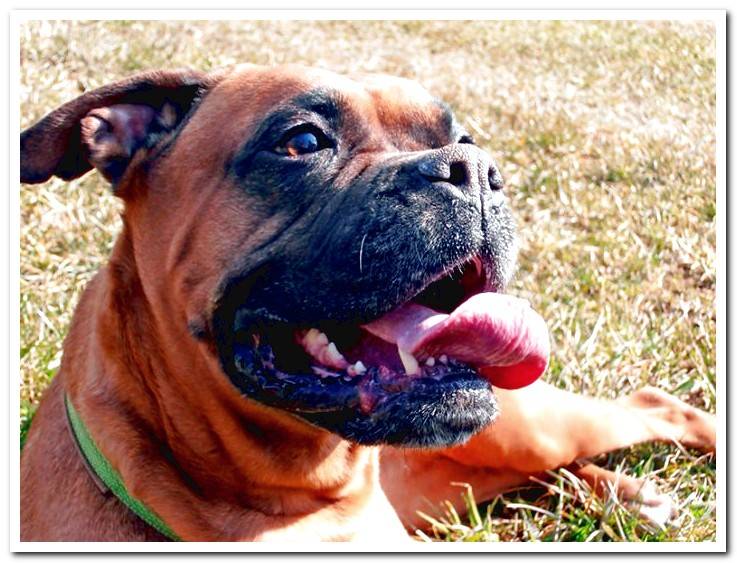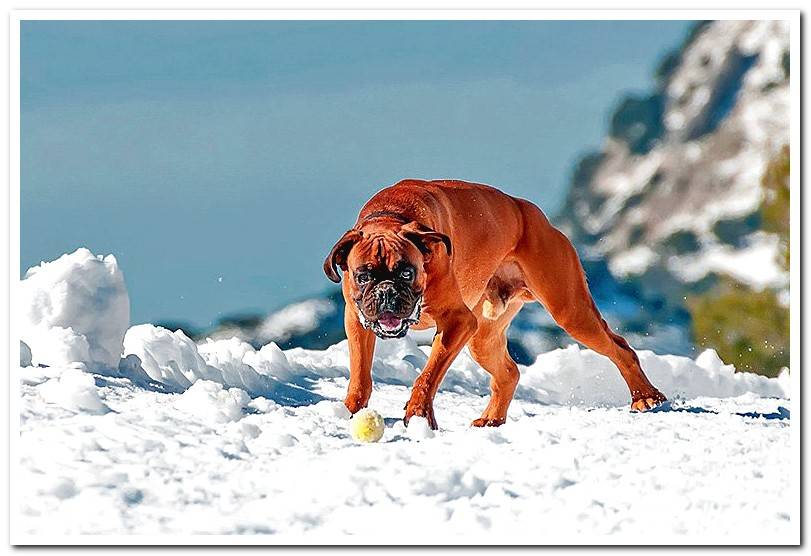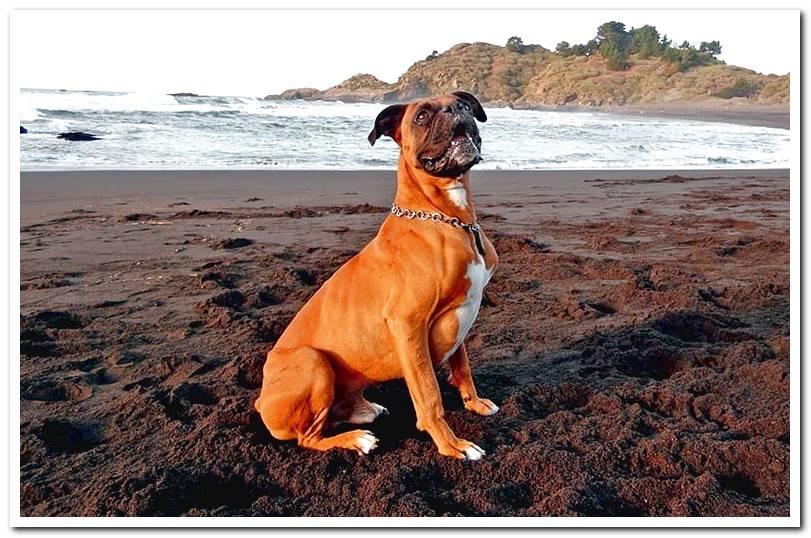
Adorable with their family and tireless playful, Boxer dogs are great companions. This, added to their privileged physique and good mood, makes them one of the most popular dogs in the world.
If what you are looking for is a dog with inexhaustible energy, easy to care for and that goes astray to make you happy, these sympathies are made for you. Do you want to know what other virtues the specimens of this breed have? We show you all its secrets.
Index of contents
- 1 Physical characteristics of the Boxer breed
- 1.1 How is the official standard of a Boxer?
- 1.2 Differences between European and American Boxers
- 2 What is the temperament of a Boxer like?
- 3 Recommended care for a Boxer breed dog
- 4 Common health problems in a Boxer
- 5 Boxer history and curious facts
Physical characteristics of the Boxer breed
Its appearance is a combination of strength, elegance and agility. They are medium-large in size, with a well-muscled build, especially on the legs. They have a powerful and deep chest and a short back. The head is slightly curved and well proportioned in relation to the rest of the body.
His eyes are rather large and have a peculiar expressiveness, which is reinforced by the typical wrinkles on the forehead of the breed. The ears are medium in size and located at the highest point of the skull. The tail is high insertion and of a medium length. The cloak is hard and well attached to the body.
|
|
Height between 57 and 63 cm in males and between 53 and 59 cm in females |
|
|
Weight of between 25 and 32 kg in males and around 25 kg in females |
|
|
Short shiny hair. The only recognized colors are fawn or tabby; there are also white specimens |
|
|
Very active and protective character. Naughty children and given to older games |
|
|
Regular health – Deafness, hip dysplasia and heart disease are the most relevant conditions to consider, in addition to possible food intolerances and / or dermatitis |
|
|
Estimated life expectancy between 10 and 12 years |

How is the official standard of a Boxer?
Copies of colors different from the two mentioned are not accepted. They may have white spots, but as long as they do not cover more than a third of their body. The eyes of a Boxer must be dark brown and they cannot be seen excessively bulging; nor be too deep. A dark line at the edge of the eye is desirable, but its lack is not disqualifying. The truffle should be wide and dark.
The standard only allows specimens with a lower jaw that is longer than the upper jaw and that curves slightly upward, without showing teeth when closed. Finally, the cheeks should not be excessively fleshy.
Differences between European and American Boxers
Although it is believed that there are two types of Boxers, in reality they are only two different lines of upbringing: the European and the American. The differences occur, above all, in the physique of the specimens. While the former have a texture that is closer to the original, broad and muscular, the Americans became more stylish and taller; in some cases the hair is slightly longer.
What is the temperament of a Boxer like?
Although its appearance imposes, a Boxer is nothing more than a large puppy. He is known as the “eternal puppy” for his always playful attitude and a bit mischievous. Is very loving with his family, especially with children, with whom he shows infinite patience.
At home they like to always be close to theirs, so don’t be surprised if they climb on your lap thinking they are Chihuahuas. Boxers drool a lot, sometimes even on top of you, and they often snore a lot. You better know sooner rather than later!
The specimens of this breed have a lot of clowns, especially if they want to show you their love. When they are happy they usually jump or dance, turning on themselves in a very particular way. If they want your attention they will make a sound that is neither a bark nor a growl.
On the other hand, they usually have no trouble adapting to small houses or flats, as long as you offer them the exercise they need, which is quite a bit. They will get along well with other dogs and cats. With unknown dogs, especially of the same sex, there may be some friction but early socialization will help polish their manners.
Boxer dogs were bred to be guardians, so it is normal for them to be suspicious of strangers. However, they don’t usually attack or be aggressive unless they detect a real threat. They are a brave and intelligent race And, if you entrust him with the care of a house, they will comply perfectly.
Training with them must be varied, as they need challenges to feel stimulated. Boxers mature slowly and will not exhibit adult behavior until age 3. Still, they will remain playful. You will have to be patient!

Recommended care for a Boxer breed dog
A boxer’s cloak requires little attention. Her short hair needs a weekly brushing and a bath only when it is really dirty They tend to groom themselves as cats do. It is also common for them to lose a lot of hair, especially in spring. Brushing teeth should ideally be daily, while nails should be cut once a month.
They are not dogs that adapt well to extreme temperatures So you won’t be comfortable spending too much time on the patio. They have a flat snout that can cause respiratory problems in very hot weather, while short hair will make them cold in winter.
Daily exercise is essential in this breed, since they are dogs full of energy. The walks should include walks and also games. He loves to jump, run, and chase small animals, so they should always be on a leash. Also, if you have a house with a patio, try to make the fence quite high.
Common health problems in a Boxer
In addition to certain predisposition to deafness – especially in white specimens – these dogs can be affected by congenital heart problems such as Boxer cardiomyopathy, which causes arrhythmia and sometimes sudden death. Another known hereditary condition is aortic stenosis, a congenital obstruction in the outlet valve of the heart that can be life-threatening.
- All about cardiomyopathy in dogs
A Boxer can also suffer canine demodicosis, a parasitic disease caused by mites that attack the dog’s skin if the dog has immunity problems. Likewise, some forms of cancer may manifest in older dogs, especially those of skin, lymphomas and brain tumors.
Hip dysplasia is an inherited condition that limits the mobility of some specimens of this breed.
Boxer history and curious facts
The Boxer’s ancestors were war dogs from Asia – among them the mighty Tibetan Mastiff – who arrived in Europe in the Middle Ages. There they came across indigenous varieties such as the Bulldog. These dogs were used for centuries to hunt for bears, wild boars and deer in the field, while in the cities they were useful for butchers who needed to control livestock. Originally they also participated in dogfights or fighting bulls, hence were originally known as Bullenbeisser (bull teethers).
The breed as we know it today developed in the late 19th century in Munich, Germany, after the crossing of a female Bullenbeisser with a dog without pedigree. The result was a much more stylish specimen, but just as strong and athletic as its mother. He was registered as BierBoxer, a name that would later degenerate into the English term “Boxer” (or boxer), which arises from the habit that these dogs have of stretching their front paws forward when they play, as if they were a boxer.
At the beginning of the 20th century, in Germany, they worked as police dogs and, later, in both world wars, where they demonstrated their courage on the battlefield. After the end of World War II they became very popular in the United States, as many American soldiers returned home with a Boxer as a life partner.
If you want to see more photos about this impressive breed or see the opinions of people who already live with them, you can visit their Facebook friends page:
- Group of Friends of the Boxer in FB
And now that you already know all the details about the Boxer, do you want to live with one?
